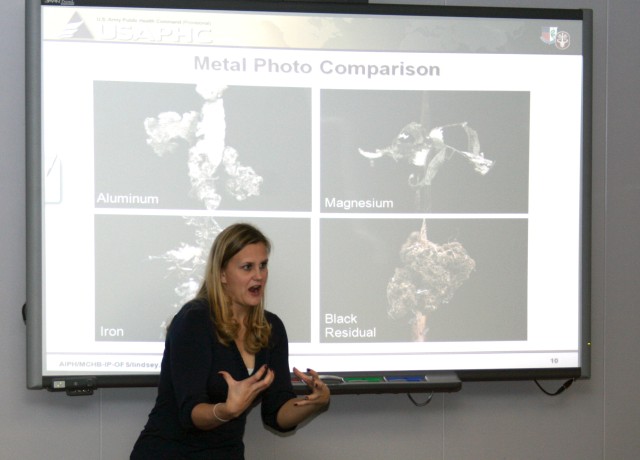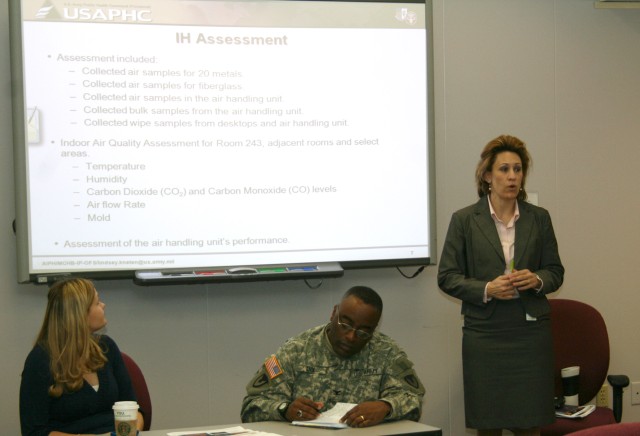ROCK ISLAND ARSENAL, Ill. - Subject matter experts from the U.S. Army Public Health Command briefed members of Army Sustainment Command's workforce about air quality in Building 350 during two information sessions held on March 2.
In January, a team of industrial hygienists from USAPHC's Army Institute for Public Health conducted indoor air sampling in various areas of the building, as well as various tests on the ventilation system. Sampling included metals, fiberglass and mold.
As a result of their investigation, it was found that all air samples collected for metal, fiberglass and mold registered within acceptable occupational exposure standards and were similar to levels in other workplace environments.
"There is no risk to their [employees'] health," said Lindsey Kneten, AIPH industrial hygienist. Although she acknowledged that there were some particles and molds present, she stated that building occupants "shouldn't get sick from the particles."
Based on the ASC Command Surgeon's recommendation, ASC requested support from the AIPH to sample the workplace air in Room 243 and the adjacent rooms as a result of a bulk sample report collected last October. These samples were collected by Rock Island Arsenal Garrison/Rock Island Integrated Systems, along with the RIA Industrial Hygiene office. Employees had also expressed concern about black particles that were present on their desks.
"We can't definitely tell what the black residual is but we know it isn't mold or fiberglass," said Kneten to meeting participants. "It is not hazardous to your health."
Maj. (Dr.) Kimberly Beck, AIPH occupational physician, reported the black material was probably carbon-based, adding "we know what it isn't".
Although the black material could not be identified, analysis by AIPH will continue and ASC has made a commitment to address these issues.
"We have experts here and the garrison is committed to fix this," said Col. Richard Dix, ASC chief of staff. "We're decisively engaged and we will stay engaged until we get it resolved."
Members of the AIPH team met with Maj. Gen. Yves J. Fontaine, ASC commanding general, and briefed him on the results of their investigation.
"The general has made a commitment to the workforce that funding will be found to fix any problems," said Dix. "Without a healthy workforce, there is no ASC."
As a result of their investigation, the AIPH Industrial Hygiene office has made a number of recommendations to improve the workplace environment in Building 350. Two of those recommendations include adding a system humidifier to moisten the dry air and cleaning out air handling ducts.
Establishing a dialogue between management and employees about health concerns was highlighted by Bethney Davidson, a risk communication specialist with AIPH. Her office recommended a "worker champion" program, providing employees in different office areas an advocate to forward health concerns to management. According to Dix, Fontaine gave his go-ahead to implement this program and the details will be worked out.
Dix concluded by reemphasizing the command is committed to the health of its employees. Sharing information about improvements being made in work conditions, laying out timelines for when things will get accomplished, requesting money for workplace improvements, and getting things done as promised are steps to improving the work environment, he said.
"We need to have a safe and viable workforce for the future," said Dix.




Social Sharing